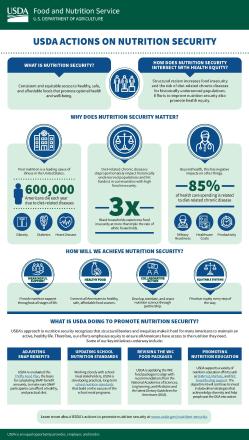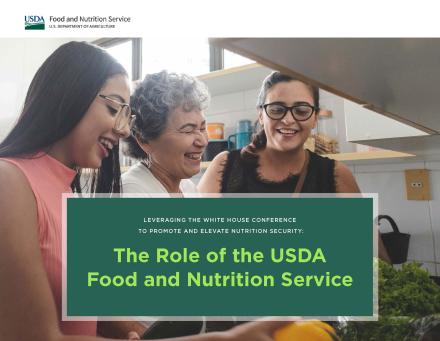What is nutrition security?
Building on and complementing our long-standing efforts to address food security, we are expanding our efforts to advance food and nutrition security. Nutrition security means all Americans have consistent and equitable access to healthy, safe, affordable foods essential to optimal health and well-being. Our approach to tackling food and nutrition insecurity aims to:
- Recognize that structural inequities make it hard for many people to eat healthy and be physically active; and
- Emphasize taking an equity lens to our efforts.
- Learn more
-
A household is food secure if all members, at all times, can access enough food for an active, healthy life. At a minimum, food security includes:
- Readily available nutritionally adequate and safe foods, and
- The ability to acquire those foods in socially acceptable ways (without resorting to emergency food supplies, scavenging, stealing, or other coping strategies).
Nutrition security means consistent access, availability, and affordability of foods and beverages that promote well-being, prevent disease, and, if needed, treat disease, particularly among racial/ethnic minority, lower income, and rural and remote populations including Tribal communities and Insular areas. Nutrition security is an emerging concept that complements efforts to increase food security while also:
- Recognizing that Americans, in general, fall short of an active, healthy lifestyle aligned with Federal dietary and physical activity guidelines, and
- Emphasizing equity to ensure our efforts serve all populations to promote access, availability, and affordability to foods and beverages, and address the connection between food insecurity and diet-related chronic diseases.
View the Infographic (PDF, 420 KB)
What is the problem?
Poor nutrition is a leading cause of illness in the United States, associated with more than half a million deaths per year. It is linked with increased risk of obesity, diabetes, and heart disease as well as broader impacts including higher health care costs and decreased productivity.
- Learn more
-
Poor nutrition is widespread
Though poor nutrition affects every demographic, diet-related diseases hit harder among historically underserved communities.
The overall diet quality score for Americans is 59 out of 100, indicating that the average American diet does not align with Federal dietary recommendations. However, the resulting health burden is not equally shared. Certain populations are at greater risk for diet-related disease. For example, Black and Indigenous children are more likely to have obesity than their white peers. Those who face food insecurity are also at greater risk.
Beyond the effect on health, poor nutrition and diet-related diseases have far-reaching impacts including decreased academic achievement and increased financial stress. That translates to societal impacts as well—lower productivity, weakened military readiness, widening health disparities, and skyrocketing health care costs. For example, approximately 85 percent of current health care spending is related to management of diet-related chronic disease.
To make progress on these problems, Americans need equitable access to healthy foods that promote well-being.
What is USDA doing?
USDA wants input from all Americans on ways we can improve nutrition security. The department is particularly focused on strengthening and building new partnerships with all levels of government, the private sector, community-based organizations, and families. Together, we can make progress that will change lives and ensure a healthier, more prosperous future for all Americans.
- Learn more
-
USDA’s work to advance nutrition security focuses on four pillars:
Research and evaluation
USDA’s work on nutrition security is driven by research and grounded in science. In addition to the extensive research performed by the Food and Nutrition Service, the Agricultural Research Service has six human nutrition research centers, the Economic Research Service studies numerous topics central to food and nutrition security, and the National Institute of Food and Agriculture advances food and nutrition security through research, education, extension, and innovation. Our work is also driven by the lived experiences – of our staff and our stakeholders.
Learn more about our nutrition security research.
Food and Nutrition Security by the Numbers
Read the Role of FNS Report (PDF, 10.0 MB)
Read the Actions on Nutrition Security (PDF, 792 KB)Read USDA Blogs on Nutrition Security
Browse all food and nutrition topics


